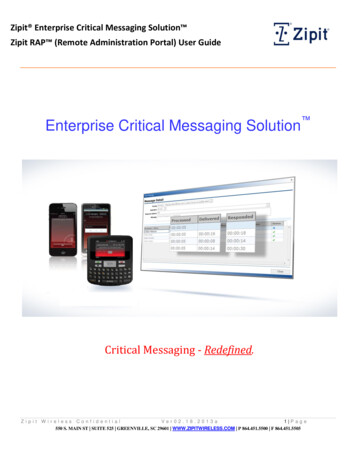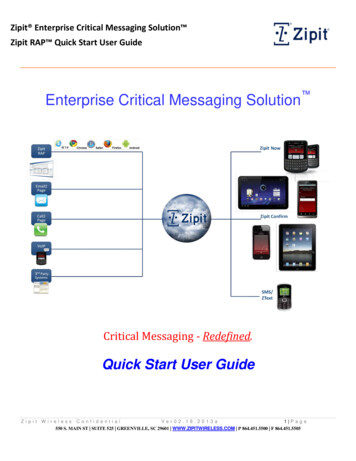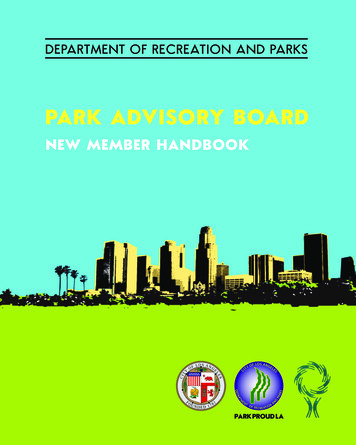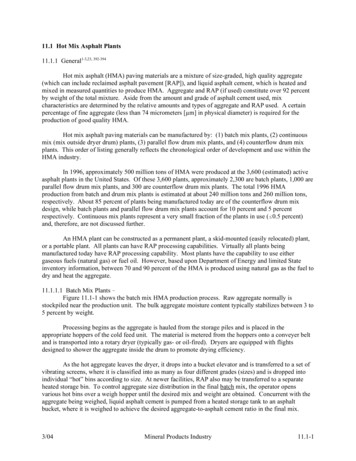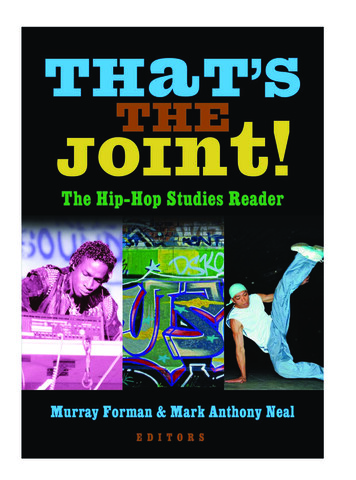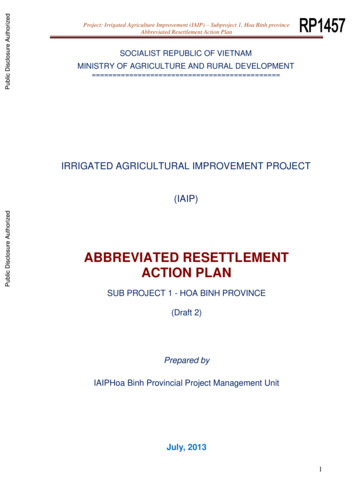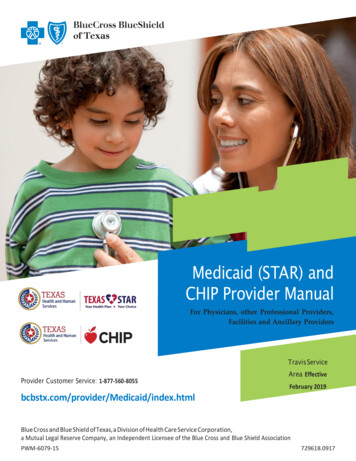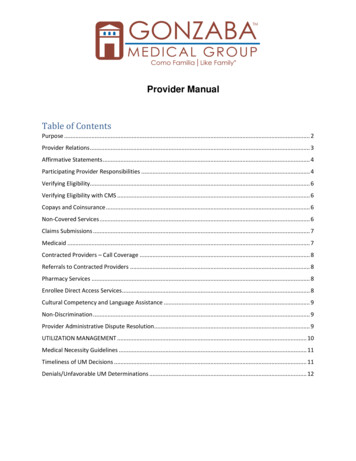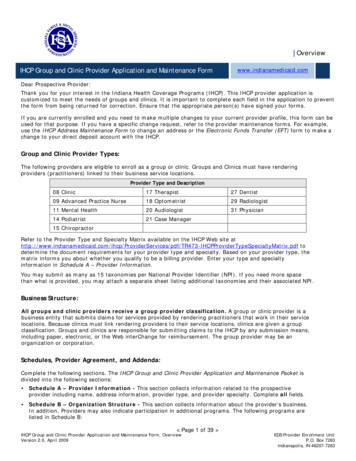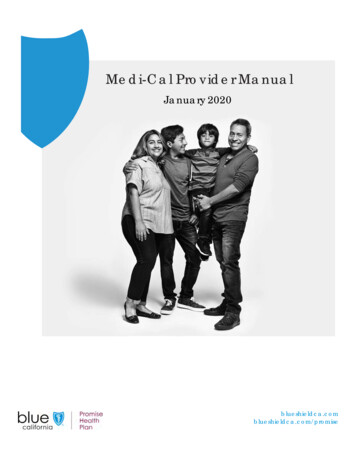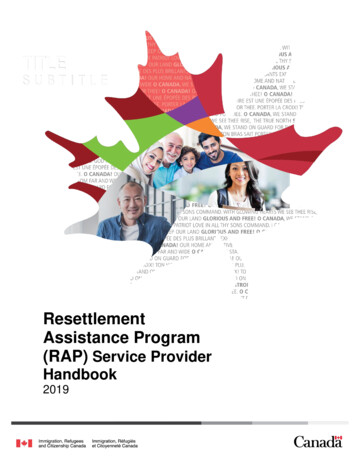
Transcription
ResettlementAssistance Program(RAP) Service ProviderHandbook2019
For information about other IRCC publications, visit: www.cic.gc.ca/publications.Available in alternative formats upon request.Également disponible en français sous le titre : Guide du fournisseur de service 2019Visit us onlineWebsite: www.cic.gc.caFacebook: www.facebook.com/CitCanadaYouTube: www.youtube.com/CitImmCanadaTwitter: @CitImmCanada Her Majesty the Queen in Right of Canada, represented by the Minister of Immigration, Refugees and Citizenship, 2019Cat. no. Ci34-5/2019E-PDFISBN 978-0-660-29280-9
Table of ContentsResettlement Assistance Program Service Provider Handbook . 61Introduction . 81.1 Canada’s refugee system . 81.2 Canadian refugee protection programs . 81.2.1 Refugee and Humanitarian Resettlement Program . 81.2.2 Help for resettled refugees . 92Before a RAP client arrives in Canada .102.1 Interim Federal Health Program Coverage Overseas . 102.1.1 Pre-departure Vaccinations . 102.1.2 Immigration Medical Exams . 102.2 Resettlement Needs Assessment . 112.3 Immigration Loans . 112.4 Pre-arrival Settlement Services – Canadian Orientation Abroad . 112.5 Other Pre-arrival Settlement Services. 133RAP Clients and their Resettlement Needs .143.1 The Resettlement Needs of GARs . 143.2 Professional development training for RAP SPO – A Trauma-Informed Approach . 154Official Language Requirements .175Port of Entry (POE) Airport Services .195.1 Receipt of Notification of Arrival Transmission (NAT) and Arrangements Prior to Clients’ Arrival . 195.1.1 Special Needs Clients . 205.2 Reception of clients at POE . 225.3 Onward Destining to City Other than POE . 265.4 Unplanned Overnight Stay at POE . 285.5 Self-Destining – Changing Final Destination. 286Secondary Migration . 327Clients’ Arrival and Temporary Accommodations. 357.1 Planning for the GAR Clients’ Arrival . 357.2 Meeting the RAP Client and Addressing Urgent Needs . 367.3 Temporary Accommodation. 378RAP Needs Assessments and Referrals . 428.1 Initial RAP Needs Assessment . 428.2 Referral to Settlement and Broader-Based Community Services. 423
9Orientation and Links to Essential Federal/Provincial Programs and Services . 479.1 Naming System . 479.2 Permanent Resident Card and Status . 489.3 Interim Federal Health Program (IFHP) . 509.4 Provincial Health Care Insurance . 539.5 Canadian Health System . 549.6 Social Insurance Number . 569.7 Canada Child Benefit . 589.8 School Registration for Children . 6010Financial Orientation – Income Support and Financial Responsibilities . 6410.1 Money . 6410.2 Banking . 6510.3 Credit . 6710.4 Immigration Loans . 6810.5 RAP Income Support. 6910.6 Budgeting . 7110.7 Guardianship for Property/Trusteeship . 7211Immediate and Essential Orientation . 7311.1 Communication and Media . 7311.2 Household Management. 7411.3 Linguistic Duality and Orientation to Local Francophone and Acadian Communities . 7511.4 Public Transportation and the Local Community . 7611.5 Canadian Weather . 7711.6 Rights and Responsibilities. 7911.7 Canadian Law and Justice . 8211.8 Family Law. 8411.9 Culture Shock and Cultural Adaptation . 8911.1012Cultural Norms and Expectations . 91Housing Orientation and Assistance in Locating Permanent Accommodations . 9412.1 Housing Orientation – Renting Accommodation . 9412.2 Assistance in Locating Permanent Accommodations . 9813Canadian Life Skills Training and RAP Exit Assessment . 10013.1 Canadian Life Skills . 10013.2 RAP Exit Assessment . 1014
14 Requests to process overseas family members under the one-year window of opportunityprovision. 10214.1 Non-accompanying family members . 10214.2 RAP SPO’s role relating to RAP clients’ OYW requests . 10215Joint Assistance Sponsorship (JAS) . 10415.1 Roles and Responsibilities . 10415.2 Recommending a Client for JAS . 10515.3 Case Conferencing Meeting . 105ANNEXES. 107Annex 1: Immigrant serving organizations and other community resources . 107Annex 2: Resettlement and Settlement Programming for Refugees: A Continuum of Supports . 108Annex 3: IRCC Guidelines for Sharing of Clients’ Resettlement Needs . 109Annex 4: List of topics covered in Canadian Orientation Abroad (COA). 111Annex 5: IOM Migrant Handover Notification . 112Annex 6: Port of Entry Airport Services – Winter Clothing Form . 114Annex 7: Port of Entry Airport Services – Client Pick Up Form. 115Annex 8: Port of Entry Airport Services – Change of Destination Request Form . 116Annex 9: Housing Search Form . 118Annex 10: IFHP Information Sheet . 120Annex 11: Interim Federal Health Certificate of Eligibility . 121Annex 12: Resettlement Assistance Program Agreement for Income Support Recipients . 122Annex 13: RAP Declaration of Funds and Assets on Arrival . 124Annex 14: JAS In-Canada Recommendation Form . 126Annex 15: JAS Roles and Responsibilities Checklist . 1285
Resettlement Assistance Program Service Provider HandbookThe Resettlement Assistance Program (RAP) Service Provider Handbook describes in detail theservices that service provider organizations funded under the RAP are expected to deliver to RAPclients. The Handbook is aimed to be used as a reference document for Service ProviderOrganizations (SPOs) delivering RAP services, and by IRCC staff as one of the bases for draftingthe content of RAP contribution agreements, and for conducting activity monitors. Use of theHandbook is also meant to ensure national consistency in the delivery of RAP services across thecountry.Last updated in 2013, the Handbook was revised in 2018-2019 following consultations within IRCC,and with RAP SPO representatives. Much the information and orientation content included in theHandbook was adapted from the Welcome to Canada publication, IRCC’s webpage for newimmigrants, or other Government of Canada websites. Updates in this version of the Handbookinclude new “What the client needs to know” sections, describing the immediate and essentialinformation that must be shared with RAP clients during the RAP service delivery period, as well as“SPO To-Do lists”, describing the immediate and essential services RAP SPOs must deliver, andtasks that they must accomplish. It also includes the following new sections: Overseas Interim Federal Health (IFH) coverage, Immigration Loans, and Pre-arrivalSettlement servicesThe Resettlement Needs of GARs – A Trauma-Informed ApproachOfficial Language RequirementsLinguistic Duality and Orientation to Local Francophone Minority CommunitiesAnd more content and details on: Referral to Settlement and Broader-Based Community ServicesOrientation to Essential Federal/Provincial Programs and ServicesRights and Responsibilities, Canadian Law and Justice, and Family LawCulture Shock, Cultural Adaptation, and Cultural Norms and ExpectationsHousing Orientation – Renting AccommodationsWhile the Handbook continues to focus on what services should be delivered, it leaves to the RAPSPOs to determine how to best deliver RAP services to their clients. Lastly, the Handbook alsodescribes the connections and continuum of services between RAP services, and pre- and postSettlement services. See Annex 2 for the Resettlement and Settlement Programming Continuum.6
The Handbook is managed by International Network’s Resettlement Operations Division (INROD). For any comments or required updates, please contact IN-ROD’s Resettlement Servicesteam at IRCC.INRAPPAR-ILPPPI.IRCC@cic.gc.ca.7
1 IntroductionIntroduction11.1 Canada’s refugee systemRefugees are people who have been forced to leave their country in order to escape war orpersecution. For reasons such as these, they are not able to return home. A refugee is different froman immigrant. An immigrant is a person who chooses to settle permanently in another country,whereas refugees are forced to flee.In keeping with the 1951 Convention relating to the status of refugees, according to the Immigrationand Refugee Protection Act, a person resettled to Canada as a Government-Assisted Refugee or as aBlended Visa Office Referred refugee is “a person who owing to a well-founded fear of beingpersecuted for reasons of race, religion, nationality, membership of a particular social group orpolitical opinion, is outside the country of his nationality and is unable or, owing to such fear, isunwilling to avail himself of the protection of that country; or who, not having a nationality andbeing outside the country of his former habitual residence as a result of such events, is unable or,owing to such fear, is unwilling to return to it.” On the other hand, persons resettled under thecountry of asylum class such as Privately Sponsored Refugees do not need to meet the abovedefinition, however, they must have been, and must continue to be, seriously and personally affectedby civil war, armed conflict or massive violations of human rights.1.2 Canadian refugee protection programsThe Canadian refugee system has two main parts: the Refugee and Humanitarian Resettlement Program, for people who need protection fromoutside Canada andthe In-Canada Asylum Program for people making refugee protection claims from withinCanada1.2.1 Refugee and Humanitarian Resettlement ProgramRefugees who come to Canada have left their homes, and in many cases they have had to live inrefugee camps for many years. When they arrive in Canada, they have to start their lives over again.Resettled refugees are selected abroad, and granted permanent residence upon their arrival inCanada. Resettled refugees can be admitted to Canada via one of the following three resettlementprograms: Government-assisted refugees (GARs) are usually referred by the United Nations RefugeeAgency, and solely government supported.8
1 Introduction o Under the Joint Assistance Sponsorship (JAS) Program, GARs with special needscan receive additional settlement support from Sponsorship Agreement HoldersPrivately sponsored refugees (PSRs) are identified and supported by private sponsors inCanada.Blended visa office-referred (BVOR) refugees are referred by the United Nations RefugeeAgency and jointly supported by government and private sponsors.1.2.2 Help for resettled refugeesUnder the Resettlement Assistance Program (RAP), the Government of Canada helpsgovernment-assisted refugees (GARs) and other eligible clients when they first arrive in Canada byproviding direct financial support, and funding the provision of immediate and essential services.Financial support includes a one-time start up allowance and monthly income support typicallyprovided for up to one year or until clients can support themselves, whichever comes first. RAPService Provider Organizations, located in communities across the country except Quebec, deliverRAP immediate and essential services to clients generally within four to six weeks of arrival inCanada. These services include: Port of entry and reception services;Temporary accommodation and assistance with locating permanent accommodation;Needs assessment and referrals to other settlement programs and community based services;Information and orientation on financial and non-financial information as well as life skillstraining; andLinks to essential federal and provincial programs.9
2 Before a GAR arrives in CanadaBefore a RAP client arrives in Canada22.1 Interim Federal Health Program Coverage OverseasThe Interim Federal Health Program (IFHP) covers certain pre-departure medical services forrefugees coming to Canada for resettlement. This coverage includes the following services: immigration medical exams and follow-up treatment of health conditions that would makesomeone inadmissible to Canada under paragraph 38(1)(a) of the Immigration and RefugeeProtection Act (e.g. active pulmonary tuberculosis and untreated syphilis)certain vaccinations aligned with Canadian immunization guidelinescommunicable disease outbreak management and controlmedical support needed for safe travel2.1.1 Pre-departure VaccinationsIf clients’ medical examination is performed by an International Organization for Migration (IOM)physician, they can receive immunizations against a defined list of vaccine preventable diseases, suchas Measles, Mumps, Rubella, Polio, and Hepatitis B. Clients will have been given their vaccinationrecord and reminded of the importance of bringing it with them to Canada.While pre-departure vaccination services offered through the IFHP are completely voluntary, clientsare reminded that immunizations are important in all stages of life to help prevent the spread ofcontagious diseases. They are also informed that in Canada, some provinces require that children beproperly immunized against certain diseases in order for them to attend a pre-school facility, orpublic/private schools. Therefore, if clients have young children, they are reminded that gettingthem vaccinated prior to departure can facilitate their registration to Canadian schools.2.1.2 Immigration Medical ExamsIRCC-approved Panel Physicians conduct Immigration Medical Examinations (IME) for all refugeesprior to their arrival in Canada. The IME includes health questions used for all applicants todetermine notably if individuals may be a danger to public health and/or public safety. Uponrequest, a copy of the IME is given to the client who can then decide whether to share the IME withtheir medical doctors in Canada.1 For privacy reasons, IRCC cannot provide copies of the IME toSPOs and sponsors. Instead, the Department shares the Resettlement Needs Assessment.1Most resettled refugees are given a copy of their IME. However, this does not include specialist reports that mayhave been conducted as part of the IME (e.g. psychiatry reports).10
2 Before a GAR arrives in Canada2.2 Resettlement Needs AssessmentThe Resettlement Needs Assessment does not include medical diagnoses, but instead focuses on theservices and medical products/medical devices the client requires. In some cases, and where thepanel physician deems critical, some diagnoses or personal information may be necessary to share,such as acute or active conditions which require special attention either during transit, post-arrival,or where a referral by a doctor may be needed soon after arrival. See Annex 3, IRCC Guidelines forSharing of Clients’ Resettlement Needs for more detail.Panel Physicians provide an opinion on the type of service clients likely required upon arrival inCanada and suggest a time frame to receive these services. While Panel Physicians provide informedmedical recommendations, they are based on a single medical encounter and rely on client disclosureof their health concerns. For this reason, it is necessary that refugees visit a primary care providershortly after arrival, as further detailed in Section 9.4 on the Canadian Health System.2.3 Immigration LoansThrough the Immigration Loans Program (ILP), the Government of Canada provides loans toresettled refugees to cover the cost of their travel to Canada. The loan document is signed by theclient at the time of the initial interview with the IRCC Migration Officer abroad.The Immigration Loan covers the transportation fees from their point of departure to their finaldestination in Canada, including the cost of non-medical escorts, if applicable. Loans are interestfree, and repayments begin one year after arrival in Canada. Generally, the time given to completelypay the loan is from 3 to 8 years, depending on the amount. The maximum loan amount per familyis CAD 10,000.2.4 Pre-arrival Settlement Services – Canadian Orientation AbroadPre-arrival settlement services provide accurate and relevant information and supports to selectedpermanent residents and refugees. These services allow individuals to make informed decisions andbegin the settlement process while they are still abroad, so that they arrive in Canada better preparedto integrate into Canadian society.Pre-arrival services are initial settlement services provided to immigrants who are located overseas,prior to receiving resettlement and settlement supports and services in Canada.Canadian Orientation Abroad (COA) sessions are in-person pre-arrival group information andorientation services for refugees; they are a critical aspect of the resettlement process. Theseservices are delivered by the IOM, and are intended to:11
2 Before a GAR arrives in Canada Help individuals selected for resettlement prepare for travel to their final destination inCanadaProvide individuals with a realistic view of Canada, including dispelling any misconceptionsSupport individuals in taking ownership of their resettlement, settlement and integrationprocessFacilitate a seamless continuum of information from pre-arrival to in-Canada resettlementand settlement supports and services (including linkages to additional pre-arrival services,RAP services, and in-Canada Settlement services)COA sessions help refugees prepare for resettlement to Canada, which includes information on, butnot limited to: Preparation for travel to Canada Provision of a realistic view of life in Canada, including difficulties that individuals mayencounter as they settle in Canada—particularly in the first few months following theirarrival—as well as information and strategies to address these challenges (e.g. cost of living,housing, finding a job) The importance of obtaining the knowledge and tools to live independently in Canadiansociety Realistic messaging on the resettlement support that individuals should expect to receivefrom RAP SPOs and/or sponsors, and the financial support they should expect to receivefrom sponsors and/or IRCC (which varies between provinces and territories and mirrorssocial services amounts). Rights and freedoms of individuals according to Canadian law, understanding of Canadianvalues, as well as their responsibilities and obligations as permanent residents and futurecitizens of Canada The linguistic duality of Canadian society and the choice available to settle in a Francophoneor Acadian Community2 outside Quebec. Other relevant pre-arrival services and in-Canada RAP and Settlement servicesSee Annex 4 for a list of general topics covered in the context of COA.The aim is for all individuals selected for resettlement to Canada to receive in-person COA training,where operationally possible. Other modes of service delivery or information provision areconsidered for circumstances where clients are more difficult to reach and serve in-person.2Francophone and Acadian communities refer to Francophone minority communities living outside of Quebec12
2 Before a GAR arrives in Canada2.5 Other Pre-arrival Settlement ServicesIn addition to COA training provided by IOM, many other organizations provide pre-arrivalsettlement services, both online and in-person (China, India, Philippines and Morocco3), includingservices in French.These free services can help clients: Learn about living and working in CanadaGet their school diploma or professional certificates recognized in CanadaConnect with employers and other members of their future communityReceive employment counselling, mentorship and referrals to other settlement servicesReceive information specific to living in Francophone and Acadian communities andservices available in FrenchThese services can also help if clients are interested in experiencing their settlement and integrationprocess in Canada in French. New employment services targeted specifically for the needs ofrefugees, are under development and will be available soon. Once available, these services will belisted on the Pre-Arrival Settlement Services website.A full list of free pre-arrival Settlement services can be found at www.canada.ca/pre-arrival-services3Services in Morocco will be delivered in French, and are set to begin in Spring 2019.13
3 RAP Clients and their Resettlement Needs3RAP Clients and their Resettlement NeedsThe following categories of refugee clients are eligible for RAP services:CategoryGovernment-Assisted Refugees (GAR)Joint Assistance Sponsorship (JAS) clientsEligibility to RAP ServicesAll RAP servicesPrivately Sponsored Refugees (PSR)Blended Visa Office Referred (BVOR)clientsPOE airport services only4Other groups admitted under a publicpolicy established by the MinisterDepends on the conditions of each publicpolicy – some public policy groups may beeligible for RAP services, while others may not.All RAP services. These clients are oftenresettled on an urgent basis.All eligible RAP services which were providedto the Head of Family, if needed by OYWclients.Eligible RAP clients arriving on TemporaryResident Permits (TRP)One-Year Window (OYW) arrivals of any ofthe abov
The Resettlement Assistance Program (RAP) Service Provider Handbook describes in detail the services that service provider organizations funded under the RAP are expected to deliver to RAP clients. The Handbook is aime
